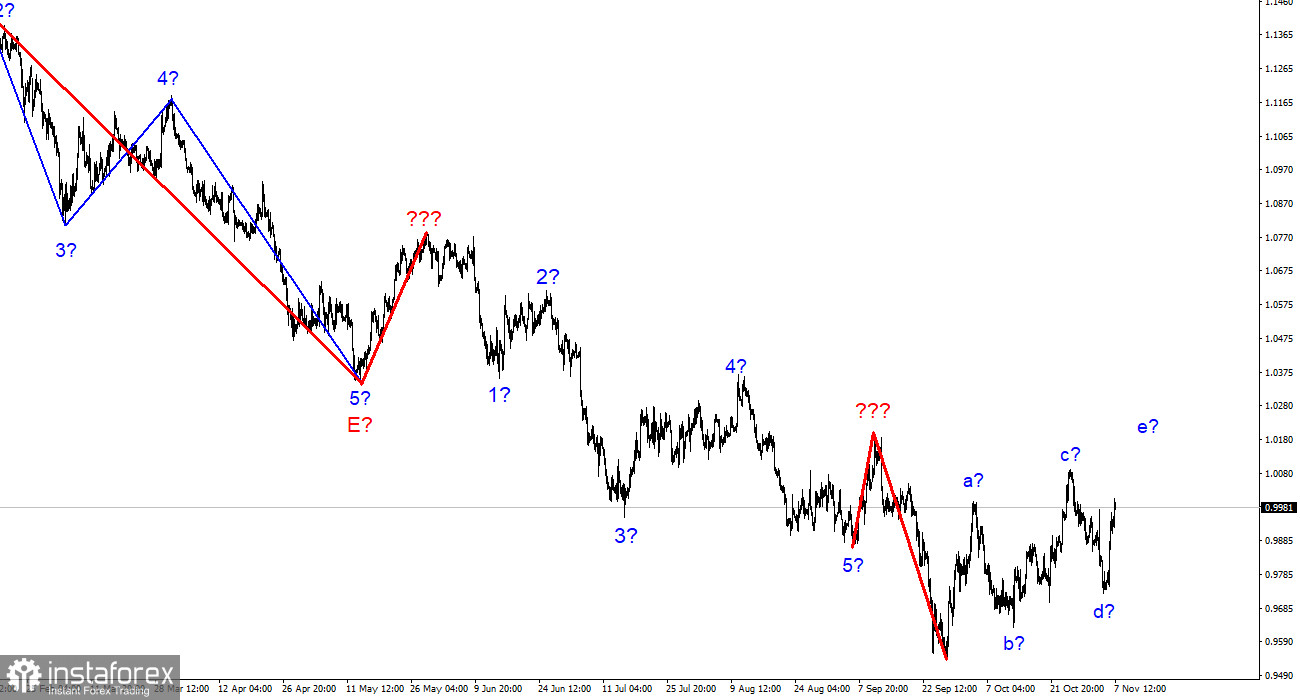
The wave marking of the 4-hour chart for the euro/dollar instrument has undergone certain changes. The upward section of the trend continues its construction, but now it takes on a pronounced corrective form. Initially, I thought three waves up would be built, but now the tool is calling to build the fifth wave e. Thus, we will likely get a complex correction structure of waves a-b-c-d-e. There is also a possibility that the latest increase in quotes is the second wave as part of a new downward trend segment. An unsuccessful attempt to break through the 0.9993 mark, which corresponds to 323.6% Fibonacci, can confirm this assumption.
The most important thing now is that the wave markings of the pound and the euro coincide. If you remember, I have repeatedly warned about the low probability of a scenario in which the euro and the pound will trade in different directions. Theoretically, this is certainly possible, but it rarely happens in practice. Now both instruments are presumably building corrective trend sections. The European currency may rise this week beyond the peak of the expected wave c, but I don't think it can go much higher than this mark.
There are no good reasons for the dollar to fall.
The euro/dollar instrument rose by 85 basis points on Monday. However, considering the gap between Friday's closing and Monday's opening, the increase is only 30 points. Although demand for the euro has been growing for most of today, the market is gradually recovering and is already openly thinking about buying the instrument. That's because there was no good reason for the dollar to fall, even on Friday. You can argue as much as you like that Jerome Powell's rhetoric on Wednesday turned out to be contradictory, and now the rate may grow more slowly. In my opinion, the main thing is that it will still grow for several months. And if Powell's rhetoric disappointed dollar buyers, then the dollar would not have grown on Thursday.
You can also talk as much as you like about Friday's unemployment reports and payrolls. I think the main thing here is that the number of payrolls continues to remain high and exceeds market expectations from time to time. And the unemployment rate, which rose from 3.5% to 3.7%, is not such a big deterioration that the demand for the dollar fell so rapidly. Moreover, from month to month, the market ignored unemployment data (the same picture is observed in the European Union and the UK). Then suddenly, this report crossed out positive nonfarm payrolls. Therefore, I believe that the problem can only be the wave pattern, which involves the construction of another rising wave. There are no other reasons for the tool to increase. The good news is that within one week, the upward wave e can complete its construction, and after that, a new downward trend section can begin, which may well be impulsive.
General conclusions.
Based on the analysis, I conclude that constructing an upward trend section will become more complicated than a five-wave one. At this time, the instrument could start building the fifth wave of this section, so I advise buying with targets above the peak of wave c, according to the MACD reversals "up." The entire trend segment originating after September 28 takes the form a-b-c-d-e, but a new downward trend segment can begin to build after its completion.
At the higher wave scale, the wave marking of the descending trend segment becomes noticeably more complicated and lengthens. We saw three waves go up, which is most likely the a-b-c structure, but two more waves will probably be built in the same structure. The construction of a downward trend section may resume after the completion of the construction of this section.
 English
English 
 Русский
Русский Bahasa Indonesia
Bahasa Indonesia Bahasa Malay
Bahasa Malay ไทย
ไทย Español
Español Deutsch
Deutsch Български
Български Français
Français Tiếng Việt
Tiếng Việt 中文
中文 বাংলা
বাংলা हिन्दी
हिन्दी Čeština
Čeština Українська
Українська Română
Română


